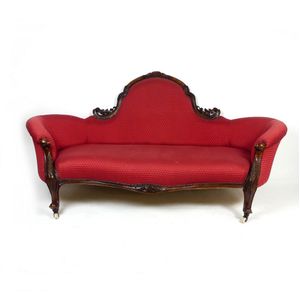Victorian Walnut Sofa in Cherry Red Upholstery
A Victorian walnut framed sofa, with carved cresting rail and shaped cabriole legs, raised on white porcelain casters, upholstered in cherry red fabric. Width 204 cm.
You must be a subscriber, and be logged in to view price and dealer details.
Subscribe Now to view actual auction price for this item
When you subscribe, you have the option of setting the currency in which to display prices to $Au, $US, $NZ or Stg.
This item has been sold, and the description, image and price are for reference purposes only.
- Cresting - The decorative carving at the top of a piece of furniture, such as a sideboard back, a mirror, or a chair back.
- Victorian Period - The Victorian period of furniture and decorative arts design covers the reign of Queen Victoria from 1837 to 1901. There was not one dominant style of furniture in the Victorian period. Designers used and modified many historical styles such as Gothic, Tudor, Elizabethan, English Rococo, Neoclassical and others, although use of some styles, such as English Rococo and Gothic tended to dominate the furniture manufacture of the period.
The Victorian period was preceded by the Regency and William IV periods, and followed by the Edwardian period, named for Edward VII (1841 ? 1910) who was King of the United Kingdom and the British Dominions and Emperor of India for the brief period from 1901 until his death in 1910. - Cabriole Leg - The cabriole leg evolved from an elongated scroll, curving out at the knee which may or may not be carved, and forming a serpentine shape as it descends to the foot.
First introduced into English furniture in the late 17th century, cabriole legs were widely used during the Queen Anne and early Georgian periods, where they frequently terminated in a pad foot or ball and claw foot. The style has had many imitators since then. The cabriole leg was re-introduced in the mid-19th century, and is commonly associated with the balloon-back dining or drawing-room chairs made in walnut, mahogany or, in Australia, cedar. The Victorian cabriole leg, on the whole, was rather more slender than the earlier form, following the French style, which emphasized the delicacy and daintiness of the chairs they were designed to support. Cabriole legs are sometimes found on windsor chairs, especially those made during the 18th century. - Rail - A term used by cabinet makers for the horizontal sections of the frame of an item such as a chair or settee which have a front rail, a back rail and two side rails, and also on a door or carcase, where the rails are joined to the vertical framings.
This item has been included into following indexes:
Visually similar items

Antique silver open back brooch, missing glass
Sold by
in
for
You can display prices in $Au, $US, $NZ or Stg.

Sold by
in
for
You can display prices in $Au, $US, $NZ or Stg.

A pair of Georgian silhouette profile portrait pictures housed in fine rosewood frames. Frames 16 x 19 cm each
Sold by
in
for
You can display prices in $Au, $US, $NZ or Stg.

A French Louis XV style marble topped commode, with a grey brown serpentine marble top above three full width drawers and sides with scrolls and feather banding in mahogany, walnut and kingwood, having a shaped apron, rococo embellishments and mounts and s
Sold by
in
for
You can display prices in $Au, $US, $NZ or Stg.
